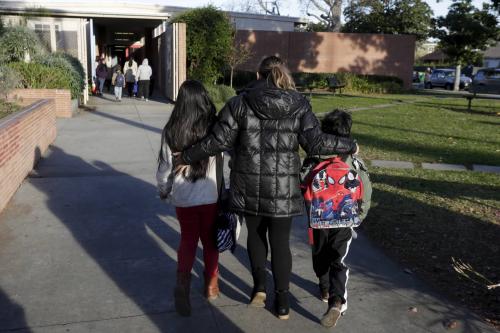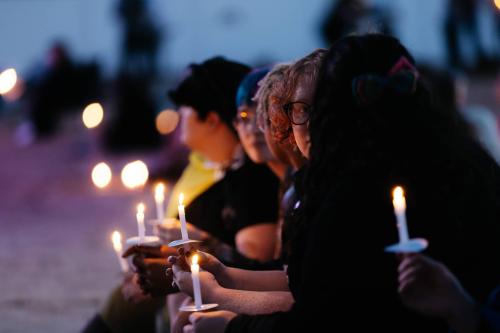Opening Remarks by Hugh Price
On behalf of the Center for Children and Families at the Brookings Institution, I want to welcome you to our policy forum on the topic of quasi-military approaches to educating students who are struggling in school and in life.
We are focusing today an interesting new set of ideas that address what I consider to be the paramount domestic challenge of our time, which is education.
Several factoids illustrate my point. The academic skills needed in the work place are beginning to converge with the skills required for success in the first year of college. The academic preparedness of the recruitment pool is one key to the quality of the all- volunteer military force. Therefore, it’s a national defense issue.
The U.S. economy will rely increasingly upon Latino, African-American, and low-income young people in the labor force. Minority students have surged to 42 percent of public school enrollment in this country. That’s up from 22 percent merely three decades ago. Yet these economically indispensable young people, along with low-income youngsters, consistently lag farthest behind academically.
We’ve made gratifying progress in some respects. Even so, according to the National Assessment of Educational Progress (NAEP), it is still the case that as recently as this year, 50 percent of Latino fourth graders read below basic, and 30 percent perform below basic in math. Fifty-four percent of African-American fourth graders read below basic, and 36 percent perform below basic in math. Also, 50 percent of youngsters who are eligible for free and reduced lunch performed below basic in reading.
The imperative to boost youngsters from below basic to basic and beyond transcends ethnicity. White students comprise roughly one third of all youngsters who are scoring in the lowest quintile, according to NAEP.
We also know that alarming numbers of Latino and African-American youngsters are dropping out of high school. Only about 50 percent of black students and roughly 55 percent of Latinos graduate from high school. Recently there has been a spate of articles about so-called drop-out factories, namely high schools that perform very poorly when it comes to graduating youngsters. Less documented, but no less ominous is the phenomenon of student disengagement.
This is why I embarked on a search for new ways to help young people who are not performing well in school and who have struggles in their lives get up to speed academically. We prepared a paper at Brookings that focuses on what can be learned from the military about educating and developing young people who are struggling in school and in life.
Why am I, as someone who never served in the military, interested in this issue? My curiosity dates back to when I was growing up here in Washington, D.C. I remember how some of my classmates in my middle school and high school, fellows we quaintly called knuckleheads and thugs, would drop out of school. A few years later, I’d encounter them. They had either enlisted in the Army or else been drafted. They were ramrod straight in their uniforms, full of purpose. I didn’t know what had transformed them, but I knew something in that two-year period, in that experience in the military, had transformed them.
I’ve heard it said that the military invests more in understanding human development than any other institution on earth. The military arguably has the best track record in our society when it comes to training and advancing minorities.
In conjunction with the paper that we prepared for Brookings, we looked at basic training, JROTC and the JROTC academies, and public military schools. We also learned about a fascinating program that ran for a while in Mississippi called the Pre-Military Development Program. It was for young people trying to get into the Army who couldn’t pass the qualifying test. So they enrolled in this intense program. In a matter of five or six weeks on average, they gained a grade and a half or two grades in reading and math. We also looked at the National Guard Youth ChalleNGe Program. This is a quasi-military residential youth corps for youngsters who have actually dropped out of school.
In the course of looking at these programs, we identified certain generic and common attributes across many of them. These include an emphasis on belonging, a strong focus on motivation and self-discipline, emphasis on academic preparation, close mentoring and monitoring of how youngsters are doing, accountability and consequences, demanding schedules, teamwork, valuing and believing in the young people, believing that they can succeed, structure and routine, frequent rewards and recognition, and of course, an emphasis on safe and secure environments.
Over the last couple of years I have been co-chairing a Commission on the Whole Child for the Association for Supervision and Curriculum and Development. The entire thrust of the commission is that for kids who are not functioning well in school, it isn’t enough to focus strictly on academic preparation. These youngsters have a lot of issues and needs in their lives that have to be addressed as well if they’re going to become successful students and successful adults. The Commission is convinced that we must concentrate on academic and emotional and social development. In addition to what must happen in schools, we need to create communities that support the development of young people.
Ironically enough, when you examine the core components of the ChalleNGe program, you see that the National Guard understands the philosophy of the whole adolescent. The core components of ChalleNGe are academic excellence, job skills, life-coping skills, responsible citizenship, health and hygiene, leadership and followership, physical fitness, and service to the community.
As part of our analysis, we thought about the potential programmatic implications of these military-like models and methods. One idea we came up with was that, given the fact that some of these programs have managed to generate very significant gains in achievement in a relatively short period of time, perhaps there could be so-called immersion programs, namely very intense summer programs, for youngsters in middle school and high school who are a grade or two behind in reading and math. The goal would be to get them up to speed very rapidly by using one of these quasi-military approaches that is different from conventional summer school.
Secondly, we felt there could be an expansion of the quasi-military public high schools, and perhaps even middle schools, for youngsters who are struggling in school and in life. Also, more public schools could embrace at least some of the generic attributes that we saw in the quasi-military approaches. We pushed beyond this to recommend that for youngsters who need to get out of their communities entirely, there should be quasi-military public boarding schools for young people.
Lastly, for kids who are caught up in the corrections system and who really want a second chance at going straight, we suggested creating quasi-military residential programs for those youngsters.
In our research, we didn’t seek to prove beyond a shadow of a doubt that these programs work. That level of proof doesn’t exist yet. Instead, we were looking for signs of significant promise. Based on the encouraging academic and developmental gains that we learned about, we decided that these programs offer that kind of potential for youngsters. In fact, instead of calling them the antidote for dropout factories, I prefer to think of these quasi-military programs as graduation factories.
Today we’re going to delve into how these programs work. I’m delighted that we have two presenters who have deep experience, as well as a number of panelists who have thought about these issues and actually have hands-on experience working with young people and with these kinds of programs. As for the format, there will two consecutive presentations, followed by a discussion among the panelists, and followed then by Q and A with the audience.



Commentary
Quasi-Military Approaches to Educating Students Who Are Struggling in School and in Life
October 31, 2007